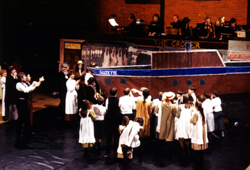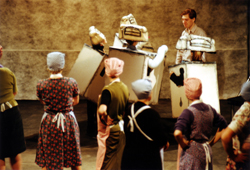The Documentary Arts Process
Each Documentary Arts project has the same basic 5 ingredients:
1. The inspiration or starting point
“How do you decide what to do?” is a question often asked. The truth is that it is not necessarily planned; it might be a lucky chance. It might be an old person’s story, a newspaper headline, an old photograph. There’s no simple answer but, if you are receptive, sooner or later, someone’s life story, some change in the local environment, a bundle of letters or a diary, could spark off a chain reaction of research which could then be developed into an arts project.
2. Recording and researching
Once you’ve found your inspiration, you’ll need to collect all the relevant information you can. It’s important, wherever possible, to find the primary source – the actual document, the original minute book or newspaper report, the actual words of eye witnesses. Free from any gloss, original materials carry within them an authenticity of statement, tone, feeling and intention that is lost when filtered through another medium. If you can preserve it, this authenticity will ring through your ultimate artistic expression, to be felt and recognised by your audiences.
3. Making the research accessible and usable
You’re not doing the research just for it to be kept in an archive and forgotten. Original documents need to be copied; those that are written in old script need to be word processed; photos need to be digitised; tape recordings need to be transcribed; photocopies need to be made, so that a group can explore the material.
4. Arrangement into an art form
The research findings can be transformed into a variety of possible art forms. Just which one will be determined by the interests and skills of those involved and the ‘appropriateness’ of the art form in relation to the material. The important point is to remain faithful to the primary source material.
5. Context for public showing
This is the most important part of the process, for Documentary Arts provide the opportunity for a community celebration, an event, performance or exhibition, when you share with the people who live in the place which yielded up its secrets the fruits of your group’s artistic endeavours. In our experience, people are not apathetic – they are just waiting to be asked to get involved in something creative and worthwhile. Once invited, they reveal a wealth of individual talents, many of which have found, so far, mainly utilitarian outlets in activities like sewing, decorating, cooking, fixing things round the house or making things at work. Give them an artistic function and they transform and flourish, making puppets or banners, props or appliqués, costumes or stage sets. People from all walks of life and of all ages can join together in a process which includes collecting primary source material relating to the past and present life of the place where they live, and giving artistic form to this material in a way that is interesting, exciting and accessible for the rest of the community.
Make a start – Dig Where You Stand
Documentary arts present opportunities to connect schools with their neighbourhoods, young people with old people, arts with life, history with now. There’s nothing magic or difficult about getting started. You’ve just got to dig where you stand. Good luck!









No Comments
Add a comment about this page